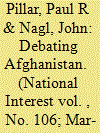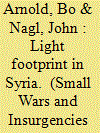|
|
|
Sort Order |
|
|
|
Items / Page
|
|
|
|
|
|
|
| Srl | Item |
| 1 |
ID:
093706


|
|
|
|
|
| Publication |
2010.
|
| Summary/Abstract |
With thirty thousand new boots on the ground, Kabul is set to become the primary focus of Obama's strategic agenda. But is this the right choice? Pillar, former national intelligence officer for the Near East and South Asia, argues that a just intervention has devolved into a worthless quagmire, while Iraq War veteran Nagl believes al-Qaeda must be vanquished in the borderlands of AfPak.
|
|
|
|
|
|
|
|
|
|
|
|
|
|
|
|
| 2 |
ID:
083034


|
|
|
|
|
| Publication |
2008.
|
| Summary/Abstract |
The US military went into Iraq with no clear understanding of or preparations for counterinsurgency. This fact, combined with poor postwar planning and failure to recognize the early development of the insurgency, severely hamstrung the American effort to secure and stabilize the country. Nevertheless, the US Army demonstrated the ability to adapt effectively from the bottom-up at the operational and tactical levels during General George Casey's tenure as commander of Multinational Force-Iraq from 2004 to 2006. Yet despite the success of population-security measures and the development of counterinsurgency doctrine, the military's top leaders in Iraq resisted the implementation of a true population-centric counterinsurgency strategy, opting instead to focus on a 'transition' exit strategy. It was not until after the transition approach collapsed amid the chaos of 2006 that counterinsurgency, and the utility of force in securing the will of the population, was embraced by America's strategic leadership
|
|
|
|
|
|
|
|
|
|
|
|
|
|
|
|
| 3 |
ID:
190721


|
|
|
|
|
| Summary/Abstract |
Special Operations Forces (SOF) played an important role in defeating the Islamic State (ISIS) physical caliphate in Syria. Acting as a force multiplier, SOF successfully mobilized, armed, supplied, and directed an indigenous guerrilla force across northern Syria against a numerically superior entrenched enemy. This effort was underpinned by a flexible operational approach that adapted operational art to the unique characteristics of unconventional warfare. This paper provides a case study on the conflict with ISIS in Syria, focusing on the first phase of the campaign from 2014 until 2016, examining the elements of operational art which had the most significant impact on the outcome of the conflict. The application of operational art throughout the campaign sought to preserve and strengthen the friendly center of gravity – the Syrian Defense Forces, or SDF – by improving access to critical capabilities, controlling tempo, recognizing culmination criteria, and properly phasing operations and resources. SOF’s practice of sustained engagement garnered influence with the SDF and provided situational awareness to key decision makers, connecting tactics to strategy, engendering mutual trust, and allowing the agility that led to battlefield success.
|
|
|
|
|
|
|
|
|
|
|
|
|
|
|
|
|
|
|
|
|